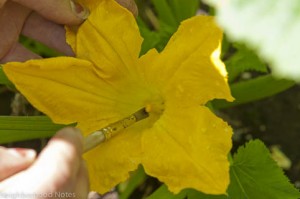Hand Pollination
 Question from Brian:
Question from Brian:
Could you recommend ,or does one of your books explain hand pollination. I would like to try this method , our summer in UK 2012 was wettest on record.
Answer from Pat:
I am so sorry to hear about you disastrous summer last year. My books explain hand pollination, including more than one method for hand pollinating certain specific tropical fruit trees, including citrus, cherimoya and guava, but these do not apply to you. Hand pollinating deciduous fruit trees is quite simple and I can explain it here and now, but you would still need a dry day because the pollen must be fresh and dry. I actually read or heard of a man using a long extension cord and going out into his orchard and trying to dry off blossoms with a hair dryer. I don’t recommend that, but it shows how frustrated people were in UK last year. If this keeps up I could imagine folks trying to think up new ways to grow fruit such as tenting the tops of trees with plastic, building individual, plastic-covered A-roofs to keep off rain or building “orangeries” to shelter the trees. My uncle who lived in the south of England had a wire house with several cherry trees in it to protect them from birds. If one had something like that one could slope the top and cover it with plastic. In damp and cold weather here I have seen large fans being used inside plastic range houses to moderate the climate for specific floral crops. Short of such a massive and expensive defense against rain, perhaps you could even drape a few branches with plastic and see if that works to keep the flowers dry.
But enough of these musings, here is the simplest way to hand pollinate which works for most flowers: Taking along a small, dry, sable watercolor paintbrush—size 7 is perfect, but 6 or 8 will do too— with you and go outdoors first thing in the morning but after the day has warmed up enough so that the dew is off the flowers. Find freshly opened blossoms containing fresh yellow pollen and simply swirl or twirl the paintbrush into the flowers and go from flower to flower and from tree to tree as you have seen bees doing. Some people simply dab the flowers. But better yet is to think like a bee and make the paintbrush behave as you have seen bees doing, rolling around inside flowers with immense joy, as if drunk. I often watched bees acting like that here and I suppose you have observed them on your fruit trees in England too. I think anyone who has really observed bees at work could not help loving them as they appear to be in some sort of frenzy of delight over what they do. Continue doing this day after day as long as the trees are flowering. If you can pollinate even a few flowers each day you stand to greatly increase your harvest. Even in rainy weather if you managed to do this between showers you might successfully pollinate some blossoms that are facing downwards or sideways and thus keeping their pollen dry enough for you to have success.


Pat
Can I use a small open bowl, humming bird feeder, or something similar to attract bees for my garden. I live in Oxnard and bee population controlled by bee keepers. I have many humming birds, will they substitute for the bees or do I still have to hand pollinate.
My problem is with UPO, ZUCCINI, ECT.
Thanks DonB
The main pollinators of squash and melons are native bumble bees, not honeybees. During recent years I have been very distressed about the dearth of bumble bees. My garden used to swarm with them but now it doesn’t and I never spray with pesticides, nor do I use any systemic products since these also harm bees. Even Spinosad, which is touted to be “organic” kills bees. A friend of mine went to Glacier National Park and said that place up by the Canadian border swarms with them. Well yes, it would with all those wildflowers and without mankind messing things up! One problem with killing bees is that it’s a great way of killing ourselves also. Part of the problem in my own garden might be my own doing since I heavily mulch my garden and bumble bees need some bare ground to nest in. Also I used to grow zinnias and bumblebees love zinnias but it’s too early to plant zinnias now. We need to wait until warm weather. May is a good time. I grow them from seeds when I do grow them and the bumble bees would sleep inside them at night. I had no problems with pollination of any of my squash, cucumbers and melons during those years. Did you know there is a ribbon you can purchase online that attracts bumble bees? http://honeybeebowcompany.wordpress.com/2012/10/27/honey-bee-bow-company/Also have you seen my U-Tube video on hand pollinating squash?http://www.youtube.com/watch?v=5Qv1_dkQLiQ If you have no bumble bees you will need to hand pollinate your plants or you could send for honeybeebow which will attract the bees in the same way zinnias attract them.